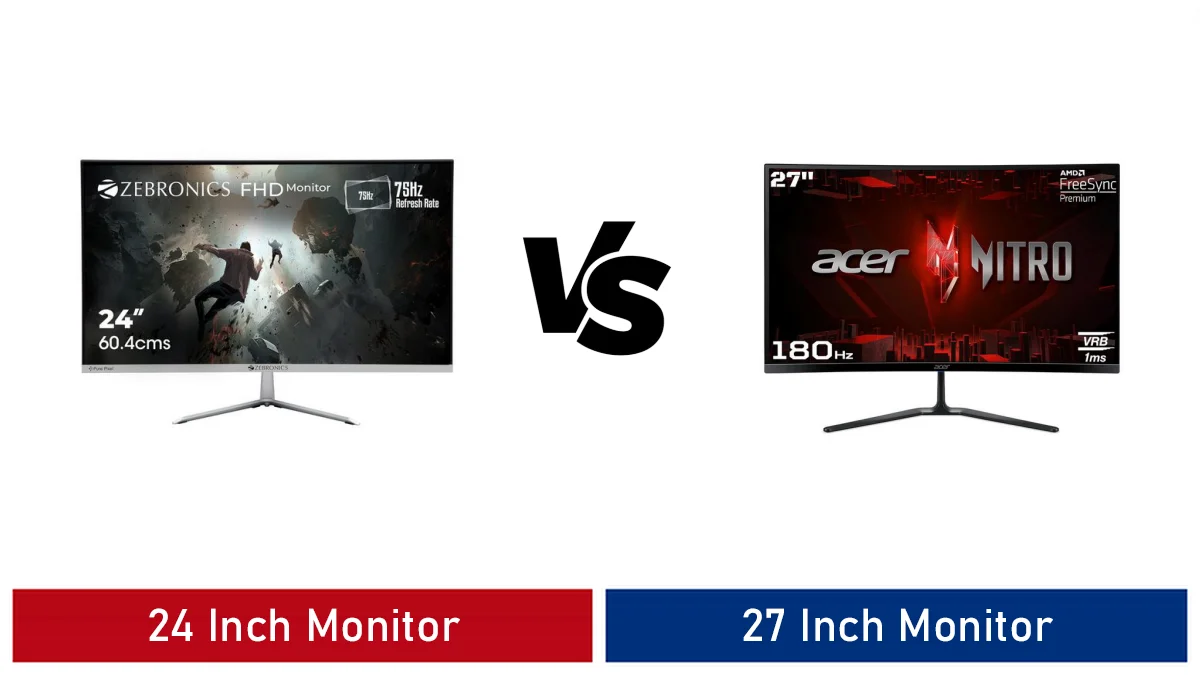
24 Inch vs 27 Inch Monitor – Monitors are an integral part of our digital lives, serving as the primary interface for computers, gaming consoles, and even smartphones.
When it comes to selecting a monitor, one of the critical decisions you’ll face is choosing the right display size.
In this comprehensive comparison, we’ll explore the differences between 24-inch and 27-inch monitors, helping you make an informed decision based on your specific needs and preferences.
Contents
- 1. Screen Size and Physical Dimensions
- 2. Resolution and Pixel Density
- 3. Gaming and Multimedia Experience
- 4. Productivity and Multitasking
- 5. Price Considerations
- 6. Ergonomics and Comfort
- 7. Space Constraints and Room Setup
- 8. Graphics Design and Visual Professionals
- 9. Final Verdict
- 10. Conclusion
- 11. 24 Inch vs 27 Inch Monitor FAQs
1. Screen Size and Physical Dimensions
Let’s start by defining the screen size and comparing the physical dimensions of 24-inch and 27-inch monitors.
1.1 Screen Size:
- A 24-inch monitor typically refers to the diagonal measurement of the display, which is approximately 24 inches from one corner to the opposite corner.
- A 27-inch monitor follows the same principle, measuring around 27 inches diagonally.
1.2 Physical Dimensions:
| Aspect | 24-Inch Monitor | 27-Inch Monitor |
|---|---|---|
| Width (in inches) | Approx. 21.2 inches | Approx. 24.1 inches |
| Height (in inches) | Approx. 12.7 inches | Approx. 14.3 inches |
The key takeaway is that a 27-inch monitor is physically larger than a 24-inch one. This size difference has implications for your desk space and viewing experience.
2. Resolution and Pixel Density
Resolution refers to the number of pixels displayed on the screen, impacting image clarity and sharpness. Let’s explore how resolution and pixel density relate to screen size.
2.1 Resolution:
- Both 24-inch and 27-inch monitors come in various resolutions, including Full HD (1920×1080), 2K (2560×1440), and 4K (3840×2160).
2.2 Pixel Density:
- Pixel density is the number of pixels per inch (PPI) on a screen.
- Larger monitors tend to have lower pixel density, while smaller monitors with the same resolution have higher pixel density.
Here’s a comparison of pixel densities for a 24-inch and a 27-inch monitor both with a Full HD (1080p) resolution:
| Aspect | 24-Inch Monitor (1080p) | 27-Inch Monitor (1080p) |
|---|---|---|
| Pixel Density (PPI) | Higher | Lower |
The result is that a 24-inch monitor with a Full HD resolution will have a higher pixel density than its 27-inch counterpart, leading to crisper text and sharper images.
3. Gaming and Multimedia Experience
When it comes to gaming and multimedia, monitor size plays a significant role in your overall experience. Let’s explore the implications of screen size in these scenarios.
3.1 Refresh Rates and Response Times:
- Both 24-inch and 27-inch monitors can come with varying refresh rates and response times, affecting gaming performance.
- Smaller monitors tend to offer faster response times, making them ideal for competitive gaming.
3.2 Immersion and Field of View in Gaming:
- A larger 27-inch monitor can provide a more immersive gaming experience, thanks to its larger display area.
- Gamers often appreciate the increased field of view in games, which can enhance situational awareness.
3.3 Impact on Video Editing and Multimedia Tasks:
- A larger screen, such as a 27-inch monitor, can be beneficial for video editing, graphic design, and multimedia tasks.
- The additional screen real estate allows for better multitasking, as you can have multiple windows or applications open simultaneously.
4. Productivity and Multitasking
For productivity-focused tasks, such as work and content creation, the size of your monitor can significantly impact your efficiency.
Let’s examine how screen size affects productivity and multitasking.
4.1 Screen Real Estate for Work:
- A 27-inch monitor provides more screen real estate, allowing you to view larger documents, spreadsheets, and web pages without zooming in.
- This can enhance your productivity by reducing the need for constant scrolling or resizing.
4.2 Split-Screen and Multitasking Capabilities:
- Larger monitors, like 27-inch displays, excel in split-screen multitasking.
- You can comfortably view and work with multiple applications side by side, making tasks like research, coding, and content creation more efficient.
4.3 The Role of Screen Size in Content Creation:
- Content creators often prefer larger monitors for video editing, graphic design, and 3D modeling tasks.
- The extra space allows for more detailed and precise work.
5. Price Considerations
Price considerations are essential when choosing a monitor. Let’s explore the price ranges for 24-inch and 27-inch monitors and their value for money.
5.1 Price Comparison for Similar Configurations:
- 24-Inch Monitor: 24-inch monitors are generally more budget-friendly, making them an attractive choice for those on a tight budget.
- 27-Inch Monitor: 27-inch monitors, especially those with higher resolutions and advanced features, tend to be more expensive.
5.2 Value for Money and Budget Constraints:
- 24-inch monitors offer excellent value for money, providing solid performance and features without breaking the bank.
- 27-inch monitors may be a better investment if you prioritize a larger screen and enhanced productivity, even if they come at a slightly higher cost.
6. Ergonomics and Comfort
Ergonomics and viewing comfort are vital factors, especially if you spend long hours in front of your monitor.
6.1 Viewing Distance and Ergonomics:
- The viewing distance should be comfortable, with the monitor positioned at eye level.
- Larger monitors may require slightly more distance for an optimal viewing experience.
6.2 Eye Strain and Comfort Factors:
- Proper ergonomics, including adjustable stands and blue light filters, can help reduce eye strain, regardless of the screen size.
- Smaller monitors may require closer viewing, potentially leading to more eye strain during extended use.
6.3 Adjustability Options for Different Screen Sizes:
- Both 24-inch and 27-inch monitors can come with adjustable stands, allowing you to customize the viewing angle and height.
- Adjustable stands enhance comfort and ergonomics, regardless of the screen size.
7. Space Constraints and Room Setup
Your available desk space and room setup can influence your choice of monitor size.
7.1 Assessing Available Desk Space:
- Measure your desk space to ensure that the chosen monitor size fits comfortably without crowding other peripherals or items.
- Smaller desks may benefit from 24-inch monitors to maximize space efficiency.
7.2 Room Size and Viewing Distance:
- Consider the size of the room and your preferred viewing distance from the monitor.
- A larger room may accommodate a 27-inch monitor with a suitable viewing distance.
7.3 Choosing the Right Size for Your Environment:
- Ultimately, your room setup and available space should guide your decision.
- Ensure that the monitor size complements your room’s aesthetics and layout.
8. Graphics Design and Visual Professionals
For graphic designers, visual artists, and professionals in similar fields, the choice of monitor size can significantly impact their work.
8.1 Requirements for Graphic Designers:
- Graphic designers often require larger monitors with high resolutions for precise and detailed work.
- A 27-inch monitor with a 2K or 4K resolution can be an excellent choice for professionals in this field.
8.2 Benefits of Larger Screens for Visual Professionals:
- Larger screens offer more room for toolbars, pallets, and multiple windows, enhancing workflow efficiency.
- The larger canvas provided by a 27-inch monitor can accommodate intricate design work.
8.3 Balancing Performance and Desk Space:
- While larger monitors provide numerous benefits for visual professionals, consider the available desk space and ergonomics.
- Ensure that the monitor size aligns with your workspace without sacrificing comfort.
9. Final Verdict
In summary, the choice between a 24-inch and a 27-inch monitor ultimately depends on your specific needs, preferences, and budget:
- 24-Inch Monitors: These monitors are budget-friendly and suitable for general use, gaming, and productivity tasks. They excel in smaller workspaces.
- 27-Inch Monitors: Larger monitors offer enhanced productivity, gaming immersion, and suitability for creative work. They are ideal for those with larger desks and rooms.
10. Conclusion
When selecting a monitor, consider the balance between your workspace, viewing comfort, budget, and intended usage.
Whether you opt for a 24-inch or a 27-inch monitor, both sizes have their advantages, and the right choice will enhance your computing experience.
By evaluating your unique requirements, you can make an informed decision and enjoy a more enjoyable and productive digital experience.
11. 24 Inch vs 27 Inch Monitor FAQs
What are the main differences between a 24-inch and a 27-inch monitor?
The main differences are screen size and viewing experience. A 27-inch monitor is larger, providing a more immersive viewing experience and more screen real estate.
A 24-inch monitor is more compact and may be preferred for smaller desk spaces.
Is a 27-inch monitor better for gaming and multimedia than a 24-inch monitor?
A 27-inch monitor can offer a more immersive gaming and multimedia experience due to its larger screen size.
It provides a wider field of view and can showcase details more prominently. However, the choice depends on personal preference and available desk space.
Which monitor size is better for productivity and multitasking?
A 27-inch monitor is generally better for productivity and multitasking because of its larger screen.
You can have multiple windows open side by side without feeling cluttered, making it easier to work on multiple tasks simultaneously.
However, a 24-inch monitor can also be suitable for productivity if you have limited desk space.
Are there any drawbacks to a 27-inch monitor compared to a 24-inch one?
The main drawback of a 27-inch monitor is that it may be too large for some desk setups, leading to a need for more desk space.
Additionally, larger monitors can be more expensive. A 24-inch monitor, being more compact, is easier to fit on most desks.
Does the resolution of the monitor affect the choice between 24-inch and 27-inch sizes?
Yes, the resolution is an important consideration.
A larger monitor with a lower resolution may result in a lower pixel density, potentially leading to less sharp images and text.
To maintain good image quality on a 27-inch monitor, consider opting for a higher resolution (e.g., 1440p or 4K) if your budget allows.
|
Related Tags
24 inch vs 27 inch monitor reddit, 24 inch vs 27 inch monitor gaming, 24 inch vs 27 inch monitor for work, 24-inch vs 27 inch monitor for coding, 24 inch vs 27 inch monitor for gaming reddit, 24 vs 27 inch monitor for work reddit, 24 vs 27 inch monitor 1080p, 27 inch vs 32 inch monitor
Last update on 2024-05-12 at 00:47 / Affiliate links / Images from Amazon Product Advertising API












